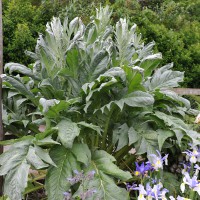Special Offers
Redeem Offer Code
Redeem Gift Voucher
Scarecrow Members
Our Feedback
Thank you for the wonderful service ,and plants.I am impressed by the eco packaging on my deliveries,wich have arrived as promised. I look forward ordering more seeds and plants later this year from my favourite nursery.
Mohammed , Khan

How to Grow Cardoons
Cardoons are similar to globe artichokes in appearance but are grown for their stalks and thick midribs, which are blanched just before harvesting. The plants make an attractive architectural addition to a border or the vegetable garden. It should be possible to harvest up to ten stems from each plant.
Planting out
Cardoons prefer a well-drained but moisture-retentive soil and a full sun position. They can be planted out from late April onwards until August/September. Set plants 3 feet x 3 feet apart (90 cm x 90 cm) as they need a lot of space.
Cultivation
Plants should be kept weed-free. Water well in dry spells. When the plants reach 12" (30 cm ) tall, provide stakes, and keep plants well watered. Plants are ready to be blanched in last summer or early autumn.
To blanch, gather the leaves together at the top of each plant, tie with soft string, and then wrap the plant with brown paper and earth up the plant at its base, to keep out the light.
Pests
Cardoons are vulnerable to attack by slugs and snails. Black bean aphids may attack leaves and stem tips, and root aphids can also be a problem. We recommend treatment with our BioFriend Plant Defence.
Harvesting
About two months after blanching, either cut down the entire plant at the base, or remove individual stems as required.
Remove autumn dieback and protect the crowns from frost with straw or similar over the winter.
Cardoon Plant 'Bianco Avorio'

A pretty vegetable widely cultivated in Victorian England and now enjoying a resurgence of popularity. It is related to the Globe Artichoke but it is the stem rather than the flower that is eaten.
Available Now
Supplied as compost block-grown plants.

 01233 740529
01233 740529


